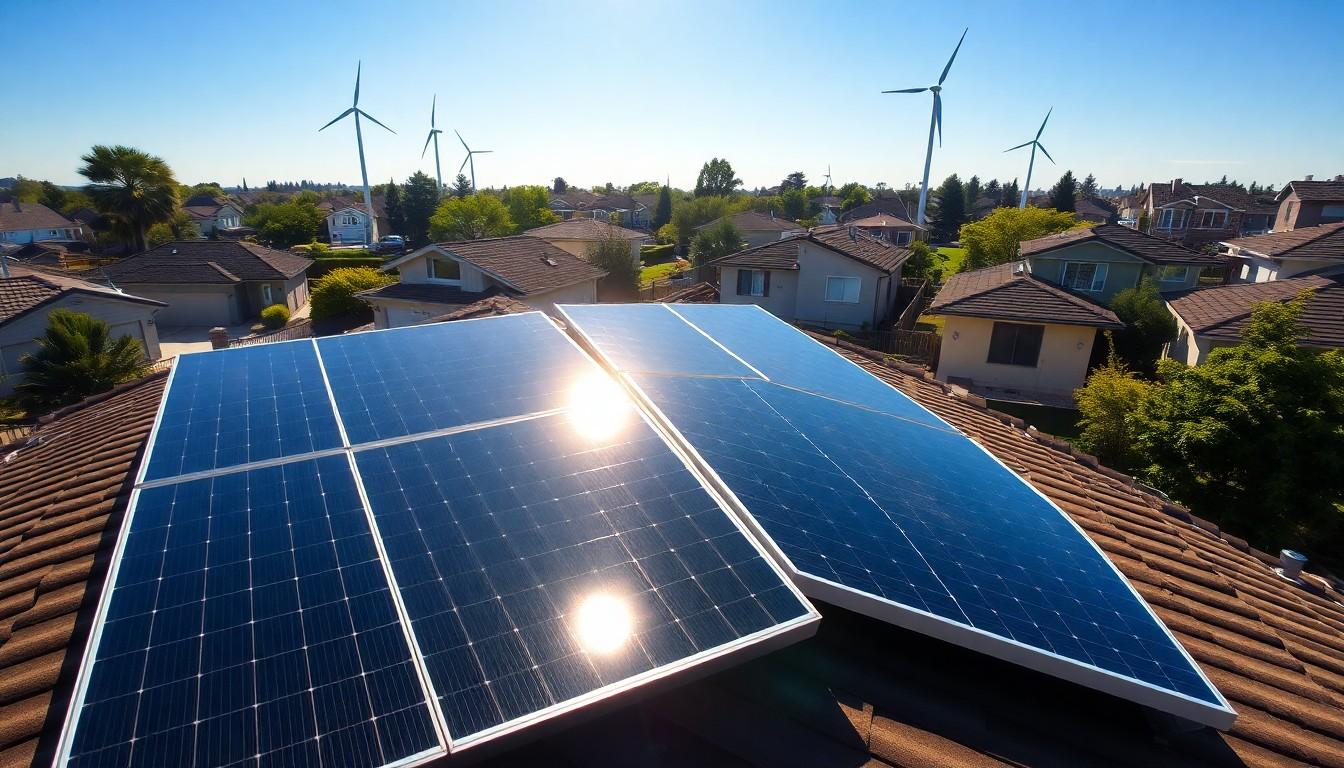Sustainable living isn’t just a trendy buzzword; it’s the secret sauce for a healthier planet and a happier life. Imagine sipping your morning coffee from a reusable cup while basking in the glow of your solar-powered home. Sounds dreamy, right? But it’s not just for eco-warriors; anyone can jump on the sustainability train without sacrificing comfort or style.
Examples Of Sustainable Living
People can embrace sustainable living through various practical approaches. Using reusable bags instead of single-use plastic reduces waste significantly. Implementing a compost system collects organic waste and creates nutrient-rich soil for gardens. Installing solar panels on rooftops harnesses renewable energy, decreasing reliance on fossil fuels.
Purchasing local produce supports nearby farmers and minimizes transportation impact. Participating in community sharing programs encourages resource exchanges, such as tool libraries or car-sharing initiatives. Choosing energy-efficient appliances lowers electricity consumption, directly benefiting both the environment and utility bills.
Adopting a plant-based diet reduces carbon footprints associated with animal agriculture. Supporting brands with sustainable practices promotes eco-friendly consumption habits. Engaging in minimalism simplifies lifestyles while asking individuals to reflect on their purchases, increasing awareness about consumer choices.
Incorporating native plants into landscaping attracts local wildlife and supports biodiversity. Reducing water usage through rainwater collection systems helps conserve this vital resource. Committing to a zero-waste lifestyle removes unnecessary materials from landfills and decreases environmental impact.
Participating in local clean-up events fosters community spirit while improving local ecosystems. Creating a home garden not only supplies fresh produce but also enhances air quality. Overall, by making mindful choices and integrating sustainable practices, individuals enhance their lives and contribute to a healthier planet.
Energy Efficiency
Energy efficiency plays a crucial role in sustainable living. By optimizing energy use, individuals can significantly reduce their carbon footprint while saving on utility bills.
Solar Power Solutions
Solar power solutions provide an alternative energy source that harnesses sunlight. Installing solar panels on rooftops often generates electricity, reducing dependence on fossil fuels. Many homeowners find tax incentives make solar installation financially appealing. Additionally, solar water heaters efficiently warm water, cutting gas or electricity use. Home batteries, combined with solar systems, allow for energy storage, enhancing resilience against outages. Communities can benefit from solar farms, which supply power to multiple households and promote shared renewable energy initiatives.
Wind Energy Utilization
Wind energy utilization presents another viable option for sustainable energy generation. Wind turbines convert kinetic energy from wind into electricity. In many areas, onshore wind farms offer a high capacity for energy production. Utilizing offshore wind farms can maximize energy output due to stronger ocean winds. Collaborative investments in wind energy projects contribute to job creation and local economic growth. Citizens participating in community wind energy projects often enjoy lower energy costs while supporting a green energy transition.
Sustainable Transport
Sustainable transport emphasizes eco-friendly methods of getting around. Choosing efficient alternatives promotes a healthier environment and reduced carbon emissions.
Electric Vehicles
Electric vehicles (EVs) operate on electricity instead of gasoline. They produce no tailpipe emissions, significantly lowering air pollution levels. Many EVs now feature advanced technology, including regenerative braking systems that enhance efficiency. Financial incentives, such as tax credits and rebates, encourage consumers to consider these clean options. Charging stations are becoming more widely available, making long-distance travel easier for EV owners. With an expanding selection of models, from compact cars to SUVs, electric vehicles meet diverse needs while supporting sustainable living.
Public Transportation Options
Public transportation options include buses, subways, and trains. These modes reduce the number of individual vehicles on the road, leading to less traffic congestion and lower greenhouse gas emissions. Many cities invest in improving transit infrastructure, making services more efficient and accessible. Commuters benefit from longer operating hours and increased routes, which encourage usage and facilitate access to jobs. Using public transport promotes social interaction and reduces personal transportation costs, creating a win-win for riders and the environment. Shifting to public transportation also supports community development, fostering more connected neighborhoods.
Eco-Friendly Home Practices
Sustainable living can be easily integrated into daily routines through eco-friendly home practices. These methods help reduce environmental impact while enhancing comfort and wellness.
Water Conservation Techniques
Water conservation techniques offer practical solutions for households. Collecting rainwater provides a sustainable supply for irrigation and non-potable uses. Installing low-flow fixtures reduces water waste while maintaining pressure. Xeriscaping utilizes drought-resistant plants to minimize water needs in landscaping. Utilizing gray water from sinks and showers for irrigation helps recycle water within the home. Each of these practices represents a commitment to sustainability while creating beautiful, functional outdoor spaces.
Sustainable Materials in Home Construction
Sustainable materials in home construction contribute to both energy efficiency and environmental preservation. Bamboo stands out as a fast-growing, renewable resource that offers durability. Reclaimed wood provides character while reducing deforestation impacts. Using recycled steel and concrete minimizes waste and energy expenditure in production. Insulation made from recycled paper products enhances energy efficiency, reducing heating and cooling demands. Choosing these materials not only benefits the environment but also creates healthier living spaces.
Sustainable Food Choices
Making sustainable food choices contributes significantly to environmental health and personal well-being. Opting for eco-friendly food sources encourages a more responsible lifestyle.
Organic Farming Practices
Organic farming emphasizes biodiversity, healthy soil, and natural pest control. Farmers use crop rotation to improve soil fertility and control pests without chemicals. These practices reduce water pollution and enhance ecosystem health. Consumers support local economies by purchasing organic produce from farmers’ markets. Organic certification ensures that food meets strict environmental standards, providing transparency for consumers. Selecting organic products means choosing food grown without synthetic fertilizers or pesticides.
Plant-Based Diet Benefits
A plant-based diet offers numerous environmental and health advantages. Reducing meat consumption lowers greenhouse gas emissions, significantly shrinking the carbon footprint. Incorporating fruits, vegetables, legumes, and grains supports nutritional health and reduces the risk of chronic diseases. Plant-based meals often require fewer natural resources, including water and land, compared to meat production. Choosing plant-based foods also promotes biodiversity by encouraging the cultivation of a variety of crops. Consuming locally sourced plant-based options further minimizes transportation emissions, enhancing sustainability efforts.
Community initiatives play a crucial role in promoting sustainable living practices. Collaborative efforts can bring people together to support local economies while fostering environmentally friendly habits.
Local Farmers’ Markets
Local farmers’ markets serve as vibrant hubs for community engagement. Shoppers enjoy fresh, seasonal produce while directly supporting local farmers. Purchasing at these markets often reduces food miles, minimizing carbon footprints associated with transportation. In addition, farmers’ markets offer a variety of organic and sustainably grown options. Participants in these markets can access educational resources about sustainable practices, reinforcing community ties and environmental awareness.
Community Gardens
Community gardens create spaces for individuals to cultivate their own food sustainably. These shared plots encourage collaboration and education among gardeners. Growing vegetables and herbs without harmful pesticides enhances local biodiversity and soil health. Community gardens often beautify neighborhoods while offering access to organic produce. Gardening workshops and events promote sustainable practices, helping neighbors connect on shared values. Participants learn about composting strategies, organic gardening techniques, and seasonal planting methods, further enriching community knowledge.
Community Initiatives
Embracing sustainable living is not just a trend; it’s a vital step toward a healthier planet and improved personal well-being. By integrating eco-friendly practices into everyday life, individuals can make a significant impact without sacrificing comfort or style.
From using reusable bags to adopting energy-efficient appliances, every small change contributes to a more sustainable future. Supporting local farmers and engaging in community initiatives fosters connection and encourages collective action for environmental health.
Ultimately, sustainable living is about making informed choices that benefit both the individual and the world around them. With a commitment to these practices, anyone can play a part in creating a brighter, greener future.






